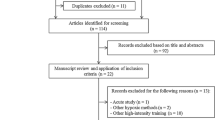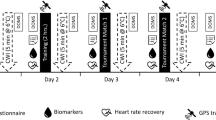Abstract
The aim of the present study was to examine the effect of cold water immersion (CWI) on sprint swimming performance in simulated competition conditions. Ten well-trained swimmers (5 males, 5 females; 19.0 ± 3.9 years) performed two 100-m swimming sprints (S1 and S2) interspersed with a 30-min passive recovery period, during which athletes were randomly assigned to 5 min of CWI (14°C) or an out-of-water control condition (CON 28°C). During tests, sprint times, heart rate (HR), pre- and post-race parasympathetic activity via HR variability (natural logarithm of the square root of the mean of the sum of the squares of differences between adjacent normal R–R intervals; Ln rMSSD) and blood lactate accumulation ([La]ac) and clearance ([La]cle) were recorded. Rates of perceived recovery (RPR) and exertion (RPE) were evaluated before and after each sprint. CWI was associated with a ‘likely’ decrease in swimming performance [1.8% (90% CI 0.2, 3.5)], as well as ‘likely’ lower peak HR [−1.9% (−3.6, −0.2)]. CWI was also associated with a ‘likely’ smaller decrease in Ln rMSSD after the first sprint [−16.7% (−30.9, −4.1)]. RPR was ‘likely’ better [+27.2% (−3.7, 68.0)] following CWI. ‘unclear’ effects were observed for [La]ac [+24.7% (−13.4, 79.5)], [La]cle [−7.6% (−24.2, 12.7)] or RPE [+2.0% (−12.3, 18.5)]. Following CWI, changes in sprint times were ‘largely’ correlated with changes in peak HR (r = 0.80). Despite a subjective perception of improved recovery following CWI, this recovery intervention resulted in slower swimming times in well-trained athletes swimming in simulated competition conditions.




Similar content being viewed by others
References
Algafly AA, George KP (2007) The effect of cryotherapy on nerve conduction velocity, pain threshold and pain tolerance. Br J Sports Med 41:365–369
Batterham AM, Hopkins WG (2006) Making meaningful inferences about magnitudes. Int J Sports Physiol Perform 1:50–57
Bergh U, Ekblom B (1979) Physical performance and peak aerobic power at different body temperatures. J Appl Physiol 46:885–889
Bloomfield DM, Magnano A, Bigger JT Jr, Rivadeneira H, Parides M, Steinman RC (2001) Comparison of spontaneous vs. metronome-guided breathing on assessment of vagal modulation using RR variability. Am J Physiol Heart Circ Physiol 280:H1145–H1150
Buchheit M, Peiffer JJ, Abbiss CR, Laursen PB (2009) Effect of cold water immersion on postexercise parasympathetic reactivation. Am J Physiol Heart Circ Physiol 296:H421–H427
Cohen J (1988) Statistical power analysis for the behavioral sciences. Lawrence Erlbaum, Hillsdale
Coulange M, Hug F, Kipson N, Robinet C, Desruelle AV, Melin B, Jimenez C, Galland F, Jammes Y (2006) Consequences of prolonged total body immersion in cold water on muscle performance and EMG activity. Pflugers Arch 452:91–101
Crowe MJ, O’Connor D, Rudd D (2007) Cold water recovery reduces anaerobic performance. Int J Sports Med 28:994–998
De Cort SC, Innes JA, Barstow TJ, Guz A (1991) Cardiac output, oxygen consumption and arteriovenous oxygen difference following a sudden rise in exercise level in humans. J Physiol 441:501–512
Gladden LB (2004) Lactate metabolism: a new paradigm for the third millennium. J Physiol 558:5–30
Halson SL, Quod MJ, Martin DT, Gardner AS, Ebert TR, Laursen PB (2008) Physiological responses to cold water immersion following cycling in the heat. Int J Sports Physiol Perform 3:331–346
Hjortskov N, Rissen D, Blangsted AK, Fallentin N, Lundberg U, Sogaard K (2004) The effect of mental stress on heart rate variability and blood pressure during computer work. Eur J Appl Physiol 92:84–89
Hopkins W (2006a) Spreadsheets for analysis of controlled Trials, with adjustment for a subject characteristic. Sportscience 10:46–50. Accessed 4 July 2009. http://sportsci.org/2006/wghcontrial.htm
Hopkins WG (2006b) Estimating sample size for magnitude-based inerences. Sportscience 63–70. http://newstats.org/ressource/stats/xSampleSize.xls
Hopkins WG, Marshall SW, Batterham AM, Hanin J (2009) Progressive statistics for studies in sports medicine and exercise science. Med Sci Sports Exerc 41:3–13
Jose AD, Stitt F, Collison D (1970) The effects of exercise and changes in body temperature on the intrinsic heart rate in man. Am Heart J 79:488–498
Lacour JR, Messonnier L, Bourdin M (2007) The leveling-off of oxygen uptake is related to blood lactate accumulation. Retrospective study of 94 elite rowers. Eur J Appl Physiol 101:241–247
Nakamura K, Takahashi H, Shimai S, Tanaka M (1996) Effects of immersion in tepid bath water on recovery from fatigue after submaximal exercise in man. Ergonomics 39:257–266
Nunan D, Donovan G, Jakovljevic DG, Hodges LD, Sandercock GR, Brodie DA (2009) Validity and reliability of short-term heart-rate variability from the Polar S810. Med Sci Sports Exerc 41:243–250
Peiffer JJ, Abbiss CR, Wall BA, Watson G, Nosaka K, Laursen PB (2008) Effect of a 5 min cold water immersion recovery on exercise performance in the heat. Br J Sports Med. Jun 6. (Epub ahead of print)
Peiffer JJ, Abbiss CR, Watson G, Nosaka K, Laursen PB (2009) Effect of cold-water immersion duration on body temperature and muscle function. J Sci Med Sport 27:987–993
Peiffer JJ, Abbiss CR, Watson G, Nosaka K, Laursen PB (2010) Effect of cold water immersion on repeated 1-km cycling performance in the heat. J Sci Med Sport 13:112–116
Pyne DB, Boston T, Martin DT, Logan A (2000) Evaluation of the Lactate Pro blood lactate analyser. Eur J Appl Physiol 82:112–116
Pyne DB, Trewin C, Hopkins W (2004) Progression and variability of competitive performance of Olympic swimmers. J Sports Sci 22:613–620
Rowsell GJ, Coutts AJ, Reaburn P, Hill-Haas S (2009) Effects of cold-water immersion on physical performance between successive matches in high-performance junior male soccer players. J Sports Sci 27:565–573
Schniepp J, Campbell TS, Powell KL, Pincivero DM (2002) The effects of cold-water immersion on power output and heart rate in elite cyclists. J Strength Cond Res 16:561–566
Stewart AM, Hopkins WG (2000) Consistency of swimming performance within and between competitions. Med Sci Sports Exerc 32:997–1001
Task Force (1996) Heart rate variability: standards of measurement, physiological interpretation and clinical use. Task Force of the European Society of Cardiology and the North American Society of Pacing and Electrophysiology. Circulation 93:1043–1065
Vaile J, Halson S, Gill N, Dawson B (2008a) Effect of cold water immersion on repeat cycling performance and thermoregulation in the heat. J Sports Sci 26:431–440
Vaile J, Halson S, Gill N, Dawson B (2008b) Effect of hydrotherapy on recovery from fatigue. Int J Sports Med 29:539–544
Vaile J, Halson S, Gill N, Dawson B (2008c) Effect of hydrotherapy on the signs and symptoms of delayed onset muscle soreness. Eur J Appl Physiol 102:447–455
Wilcock IM, Cronin JB, Hing WA (2006a) Physiological response to water immersion: a method for sport recovery? Sports Med 36:747–765
Wilcock IM, Cronin JB, Hing WA (2006b) Water immersion: does it enhance recovery from exercise? Int J Sports Physiol Perform 1:195–206
Yeargin SW, Casa DJ, McClung JM, Knight JC, Healey JC, Goss PJ, Harvard WR, Hipp GR (2006) Body cooling between two bouts of exercise in the heat enhances subsequent performance. J Strength Cond Res 20:383–389
Acknowledgments
The authors thank the swimmers for their enthusiastic participation.
Author information
Authors and Affiliations
Corresponding author
Additional information
Communicated by Jean-René Lacour.
Rights and permissions
About this article
Cite this article
Parouty, J., Al Haddad, H., Quod, M. et al. Effect of cold water immersion on 100-m sprint performance in well-trained swimmers. Eur J Appl Physiol 109, 483–490 (2010). https://doi.org/10.1007/s00421-010-1381-2
Accepted:
Published:
Issue Date:
DOI: https://doi.org/10.1007/s00421-010-1381-2




